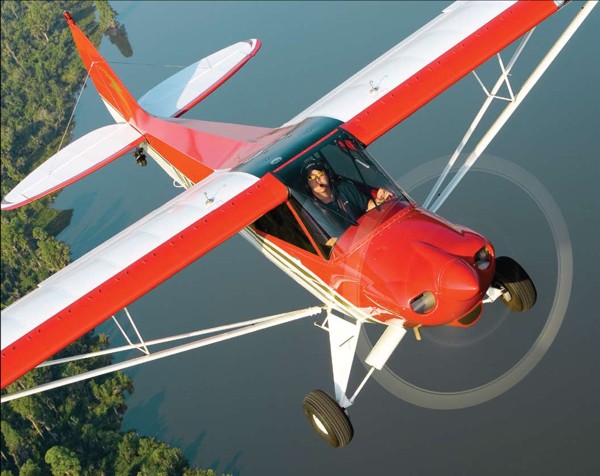
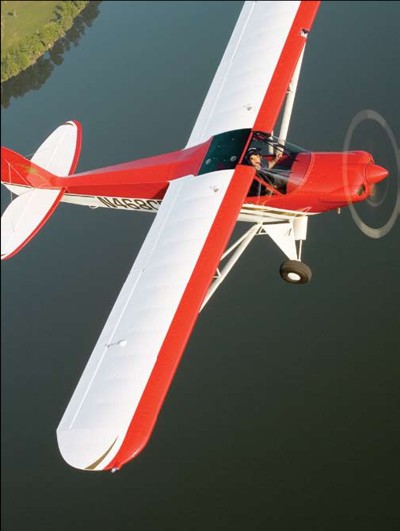
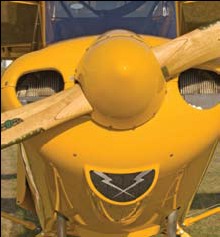
Power for the Sport Cub is a 100-hp Continental
O-200 engine, with either a Sensenich wood propeller
or optional McCauley metal prop|appropriate
for those folks planning to put the Sport
Cub on floats.
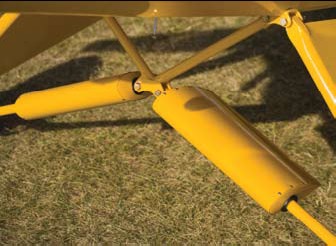
The Sport Cub has a traditional bungee cord suspension system, but it’s dressed up a bit with covers to keep dirt and debris out.

The “office” of the Sport Cub
features a traditional side throttle along with fuel selector switch. While this particular Sport Cub is equipped with an optional full glass panel, CubCrafter’s
offers a more traditional panel. To accommodate folks of Jim Richmond’s height, the Sport Cub’s cockpit is 30 inches wide and 52 high.
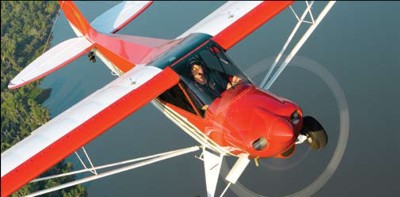

The back seat in the Sport Cub has a hammock-style back that can be rolled up and stored like header …

Jim Richmond demonstrates the technique.

… resulting
in a large storage area that can hold up to 100 pounds of cargo (if within weight and balance limitations).

CubCrafters Debuts ‘Carbon Cub’
Proof Of Concept

The S-LSA Useful Load Requirement
Vintage Looks Mated With Modern Materials
Take 25 years of experience
with rebuilding Piper Cubs,
add a new FAA regulation
allowing more flexibility in designing
and producing aircraft, spice the
mixture with many design changes,
and you get CubCrafters’ Sport Cub.
The Yakima, Washington-based company
has created an airplane that retains
the vintage look of a J-3 Cub
but embraces 21st century materials
and technology.
On a warm evening during
the Sun ‘n Fun Fly-In
at Lakeland, Florida, I
flew with CubCrafters’
pilot Clay Hammond. He
identified company President
Jim Richmond as the primary
motivator behind the Sport Cub.
Richmond has been rebuilding Cubs
for 25 years, during which time he
conceived many changes he wanted
to try. Taking into consideration his
height-he’s 6 feet 4 inches tall-he
wanted to make all the improvements
he’d envisioned for the venerable
Cub, and he wanted the airplane
to fit him.
A Thoroughly Modern Cub
CubCrafters took on the redesign
of the 50-year-old airplane using
modern materials and engineering
software not available to Piper engineers
when the J-3 was created. The
result is a stronger, lighter weight
fuselage structure. CubCrafters Vice
President Todd Simmons said the
company made extraordinary efforts
to lighten the Sport Cub’s airframe
to stay within the maximum
gross weight allowed for light-sport
aircraft (LSA)-that’s 1,320 pounds
for landplanes and 1,420 pounds for
seaplanes. One example of this effort
is a cowling built of composite
materials instead of aluminum. Additionally,
the Sport Cub’s wingtips
have a carbon fiber component that
sweeps from a D-cell shape to a tubular
shape at the trailing edge.
The Sport Cub’s main fuselage
structure uses composite stringers for
shaping where cosmetic finish is the
goal. Wherever structural strength is
important, CubCrafters uses steel or
aluminum.
In many places where a steel part
might be used, the Sport Cub uses a
machined aluminum billet fashioned
into a specialized part, according to
Clay. The effort was made in the interest
of saving ounces, but the parts
are beautiful. At the base of the Sport
Cub’s joystick are handsome aluminum
machined fittings that function
as ailerons linkages.
Overall, the Sport Cub exhibits excellent
finish work from the machined
parts to the beautiful paint job. Clay
attributed that to Richmond’s many
years of involvement with this airframe.
Poly-Fiber coverings and coatings
are used to the silver finish stage,
with PPG paint used for the attractive
final finish.
The Sport Cub manages to preserve
the image of an original Cub while delivering
an all-new design with significant
redesign work to address ASTM
standards. Retro automobiles like the
Thunderbird also hark back to the familiar
models of yesteryear yet add
new construction technology to the
mix. Appropriate to the Sport Cub’s
contemporary premise, the entire
plane was created with SolidWorks
engineering software.
The final evidence of CubCrafters’
work to shave weight wherever possible
is that Sport Cub number one,
N468CB, has an empty weight of
877 pounds according to the pilot’s
operating handbook in the airplane.
That weight would permit another 13
pounds of equipment and yet still be
within the ASTM standards requirement
that all S-LSA have a minimum
useful load of 430 pounds. Most original
Cubs had no electrical systems,
but the new millennia Sport Cub
does, to accommodate avionics and
a built-in landing light in the wing.
And it has two 12-gallon fuel tanks
located in the wings.
The Feel Is Real
Similar to authentic Piper J-3s, the
Sport Cub has no door on the left
side. In exchange for entry there’s a
broad window offering good lateral
vision and a somewhat aft view. The
windshield is also large as it extends
into a skylight, which adds lateral visibility
in turns.
Open-cockpit flying lovers can rejoice.
The Sport Cub’s windows and
door may be opened at any time during
flight. However, Clay indicated
that if you are “tached up” (that is,
the engine revving high), it gets
pretty windy inside. He sets power
at about 2100 rpm to have a better
open-cockpit flying experience. Why
fly with the windows open at the
highest speed the Sport Cub can muster,
especially considering how well it
slows down?
The Sport Cub’s floorboard is a
single piece of fiberglass that is built
into the airplane as it is assembled;
it lends a quality finish and coordinates
well with the handsome machined
parts.
The aft, hammock-style seat can be
folded up to effectively become part of
the headliner. Once it’s stowed properly,
the back area opens up for other
uses. The Sport Cub can be loaded
with 100 pounds in this aft area plus
another 20 pounds in the hat rack, assuming
the cargo is well secured and
remains within the weight and balance
envelope. This aft area’s versatility
adds value to those wishing to use
the Sport Cub as a bushplane.
To improve support when used by
a passenger, carbon-fiber pieces are
added to lend structure. A cushion
goes on top of the basic seat for additional
comfort.
Our test Sport Cub had a sturdylooking
Aircraft Spruce tail wheel.
However, bush pilots will want to
upgrade to the optional Scott tail
wheel, which puts more surface on
the ground. The Sport Cub’s landing
gear has a bungee cord suspension
like original Cubs, though the cords
are modernized with a fairing cover.
Slow-Flying Delight
Here’s my confession: I’m a longtime
ultralight pilot who appreciates the
ability to fly slowly over the landscape.
When I discovered the great slow-speed
qualities of the Sport Cub, I knew I’d
like it for low-and-slow flying.
On landing, we used one notch of
flaps and powered back substantially
abeam the landing point. We used 65
mph on base leg and 55 mph on approach.
These comfortably low numbers
are merely a baseline. Clay said when
flying solo, well under gross, he can
approach safely at 45 mph (39 knots),
which allows landings in small spaces.
The Sport Cub’s optional flaps have
a noticeable effect when you deploy
them. The first notch of flaps, normally
deployed at a higher airspeed,
caused a significant pitch change. To
best operate these flaps, you first relieve
the pressure on the flap handle
before deflecting the detent release
with your thumb. When adjusting to
a new setting, you first move the lever
slightly and then engage the detent
tab. Flap forces were light, making
this an easy adjustment.
Clay described a technique he uses if
he wishes to loiter in the pattern, perhaps
to allow traffic ahead more spacing.
He puts down full flaps and enters
slow flight, dropping the airplane to 28
mph while holding altitude. My own
test of this technique quickly gave reassurance
that it’s possible. The Sport
Cub slows down marvelously.
Despite a good bit of taildragger
experience, I bounced slightly on my
early landings. There was a brisk crosswind
at South Lakeland Airport during
my evaluation flight. In such conditions,
Clay likes to execute wheel
landings. Therefore, I did likewise,
though my usual method is the fullstall
landing on three points of a taildragger.
Clay’s technique is to come
in tail low and plant the mains fairly
authoritatively. Once the mains are
on to stay, he eases the stick forward
to maintain this posture. I tried this
technique to achieve my best landing
of the bunch.
While taxiing, I was pleasantly
surprised to find that you can see
over the nose quite well despite the
taildragger deck angle, and the Sport
Cub’s brakes proved potent. You can
break loose the tail wheel to pivot on
the mains once your technique is sufficiently
practiced.
My Dutch roll coordination exercises
went well from the start. Over
the years, I’ve found this to be a reliable
way to judge overall control
authority, response, and harmony.
Many airplanes require a few hours
of experience to appreciate their
fine points; others come quickly,
and the Sport Cub is in the latter
group. However, I found the joystick
seemed a bit heavier in control motions
contrasted with the powerful
rudder pedals.
As cleanly executed as the joystick
hardware was, the stick became rather
slippery in my hand; I’d prefer a more
tactile grip. Fashioned out of an aluminum
tube, the diameter was thin
and thus difficult to hold.
Steep turns done at 2500 rpm
(about 75 percent power) required
no additional power to hold altitude,
and I did not have to change trim to
sustain the turn. In the steep turn
without a trim adjustment, I found a
fair amount of stick backpressure was
required, but I was easily able to hold
the turn to within 100 feet of deviation
through two full circles. This was
true in either direction.
Stalls in all simulations worked
without surprise. Given the Sport
Cub’s wonderful low-speed capability,
I expected stalls would be docile,
and they were. My longitudinal stability
check went equally uneventful
as well. The same can be said for power
response checks with no sustained
oscillation before the Sport Cub responded
in the correct direction.
At 2450 rpm, approximately 65
percent power, I saw about 88 mph
(76 knots) on the airspeed indicator.
At this power setting Clay believed
fuel consumption would be about 5
gph. Bumping power to 75 percent
would raise the burn rate to 5.5 gph,
he thought, and speed climbed into
the low 90s.
In a timed descent checked through
120 seconds, I saw a sink rate of about
420 fpm. With the engine idling and
producing plenty of drag, this qualifies
as excellent in the LSA category.
Later in the day, with conditions mellowing,
the vertical speed indicator
confirmed this idle-power sink rate.
As you look over the Sport Cub,
you’ll notice vortex generators on the
wings’ upper surface. They contribute
to its slow speed flying capability
but set the CubCrafters’ version apart
from other LSA Cubs in one more way.
Though Cubs are known for their highlift
wing, the generators do a good job.
On his departure to the Plant City
airport, Clay demonstrated a short
takeoff roll in the Sport Cub flown
solo after the heat of the day passed.
I estimate he was off in less than 150
feet. I also noticed that the Continental
engine is considerably noisier than
a Rotax lifting a similar weight.
Top-of-The-Line Cub
The Sport Cub is nicely finished,
but that heightened level of professionalism
comes at a price premium.
The base price of the Sport Cub is
listed at $99,500 in spring 2007. But
that doesn’t include the flaps I used
($6,500), the twin fuel tanks (12 gallons
is standard; 24 gallons will cost
$1,700), or all the panel goodies.
Nonetheless, a base-price Sport Cub
is a well-equipped machine. On the
panel you get an airspeed indicator, altimeter,
compass, tachometer, oil temperature
gauge, oil pressure gauge, inclinometer,
and Garmin SL40 VHF communications
transceiver. If you want
GPS and glass instrumentation, you
can spend $10,000 to $20,000 more.
An intercom adds another $1,000. If
you want colors other than the “standard
Cub” look, optional paint adds
$2,900, and the obligatory emergency
locator transmitter adds $1,100.
The Sport Cub I tested would approach
$130,000 in price. But for this
premium, you get an airplane essentially
built in a Part 23 environment,
the same as used by Cessna, Cirrus,
and Diamond. You also get an airplane
that complies with the ASTM
useful load requirement. In fact, Cub-
Crafters “prices” the Sport Cub in
dollars and pounds.
The ASTM standards for LSA call
out a minimum useful load of 430
pounds; that value subtracted from
the maximum gross weight of 1,320
pounds means no 100-hp two-seat SLSA
landplane can weigh more than
890 pounds empty. Buyers have a reasonable
duty to examine an S-LSA’s
weight and balance information to
assure any plane that interests them
actually meets ASTM guidelines.
With its base price equipment,
CubCrafters says the Sport Cub will
weigh only 825 pounds empty, as a
result of the company’s extensive effort
to keep weight down. With the
basic options I specified above, the
Sport Cub should weigh 856 pounds,
well under the 890-pound maximum.
This means if you simply must
have more options, CubCrafters has
planned well and worked hard to allow
you make your Sport Cub the
Cub you want.
Reflecting on the care and long experience
used by CubCrafters to create
its LSA, you realize not all Cubs are created
equal. If you are a particularly demanding
buyer, the Sport Cub should
make a great choice for you. Get informed
via the company’s website, and
then get a demo flight. A Sport Cub
might look good in your hangar.
| Seating | 2, tandem |
| Empty weight | 825 pounds |
| Gross weight | 1,320 pounds |
| Wingspan | 34.8 feet |
| Wing area | 176 square feet |
| Wing loading | 7.5 pounds/square foot |
| Length | 23.3 feet |
| Cabin Interior | 30 inches |
| Height | 8.4 feet (tail down) |
| Fuel Capacity | 12 gallons 1 |
| Baggage area | 130 pounds total 2 |
| Airworthiness | Certified SLSA |
| Notes: | 1 24-gallon optional capacity, two tanks 2 110 pounds behind copilot seat; 20 pounds in hat rack |
| Standard engine | Continental O-200 1 |
| Prop Diameter | two-blade wood, Sensenich 72×44 |
| Power | 100 hp at 2700 rpm |
| Power loading | 13.2 pounds/hp |
| Cruise speed | 91 knots/105 mph |
| Stall Speed (Flaps) | 31 knots/36 mph |
| Never exceed speed | 120 knots/138 mph |
| Rate of climb at gross | 800 fpm |
| Takeoff distance at gross | 250 feet |
| Landing distance at gross | 200 feet |
| Range (powered) | 550 miles, 6 hours (no reserve) |
| Fuel Consumption | about 4-5 gph 2 |
| Notes: | 1 Time between overhauls-1,800 hours 2 See article for more consumption info. |


Is Continental producing the 0-200? I thought that that engine was long gone. What pitch prop can you get? Anything close to a bore prop? Also float fittings. Thanks.! —George in Alaska.
By all means, contact Continental Aerospace and inquire.